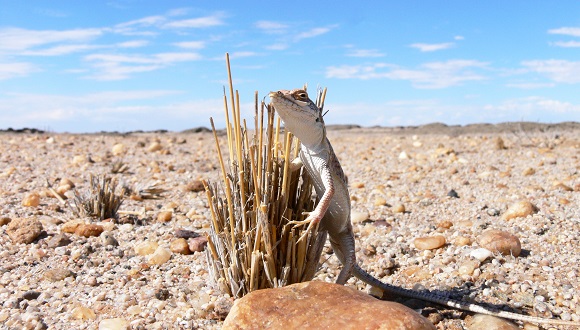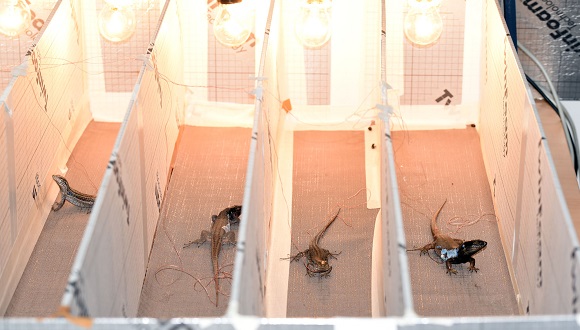Cool lizards do not like global warming!
Climate change is toppling our Earth's ecosystems out of balance in multiple ways, with often dramatic consequences. Many plants and animals are already impacted. But surprisingly, it is only poorly understood which are the specific threats, and how the actual consequences will look like.

Lizards are a group of animals that proverbially love the sun (they are called “heliotherms”). Because these are cold-blooded animals, they depend on warmth and solar radiation to attain the temperatures they like. So the obvious hypothesis would be that they will benefit from global warming. But will they?
A team of 45 researchers from 17 countries has now come closer to answering this question in a study published today in Nature Communications. The researchers focused on the physiology of the so-called lacertid lizards, a group that is widespread in Europe, Asia and Africa. Lacertid lizards contain species occurring in the blazing heat of the Namib desert, but many others are restricted to chilly habitats on mountains above 2000m in Europe. One of them, the viviparous lizard, even reaches the Arctic Circle, farther north than any other reptile.
The study experimentally determined which temperature lacertid lizards prefer, and how tolerant they are against water loss in arid conditions, against the backdrop of their evolutionary tree. It was known that lizards in tropical environments often operate at temperatures very close to those of the environment, and this was not different in tropical lacertids - when climate change leads to a temperature increase in their environment, they may not be able to persist.

"We found in these lizards a strong adjustment between physiology and environmental temperature and this likely makes them very sensitive to global warming” says Joan Garcia-Porta, researcher at the Centre for Research on Ecology and Forestry Applications, CREAF, Spain and currently at Washington University in St Louis, USA, the first author of this study.
But what about lacertids in temperate environments? Based on newly compiled physiology data of over 50 species, the researchers found that much of their biology is equally determined by climate. Miguel Vences, a co-author and professor of evolutionary biology at the Braunschweig University of Technology, comments: "It was amazing to discover how neatly these species are adapted to their environment. Their physiology, size of distribution ranges, species richness, and even mutation rates - everything correlates strongly to the temperatures they experience in the wild."
The study used state-of-the-art DNA sequencing methods and analyses of fossils to reconstruct the evolution of 262 species of lacertid lizards. According to Iker Irisarri, a researcher at the Spanish Research Council CSIC in Madrid who contributed to these analyses: "These animals in Europe have been the focus of hundreds of studies over the last years. Our new genomic analyses finally ascertained how they relate to each other in evolutionary terms, and when they originated."
Glimpsing into the past of lacertid evolution showed that many of them originated in warm past climates, but since then they have adapted as the Earth cooled down, and spread into very cold regions in the process. "The story of non-tropical lacertids is one of persistence against cold. There has been no precedent in their evolution to cope with either heat or with dry conditions for millions of years" says Katharina Valero, a lecturer at the University of Hull, UK.

Confirmation of the study's hypothesis comes from the perhaps most cool- and moist-loving viviparous lizard. "Populations in the Pyrenean Mountains where environmental temperatures come close to their preferred temperatures are already extinct - a presage of what might happen with other lizards." says Barry Sinervo, a professor at University of California at Santa Cruz who has been studying lizard declines for over 10 years.
Miguel-Angel Carretero, a lizard specialist at CIBIO institute, Portugal, adds: "The mechanisms by which these lizards decline are complex, but we start to understand them better. Warmer temperatures also mean lower humidity, and climate change forces these lizards being active in dry environments that they cannot cope with".
Article:
Joan Garcia-Porta et al. Environmental temperatures shape thermal physiology as well as diversification and genome-wide substitution rates in lizards. Nature Communications. DOI: 10.1038/s41467-019-11943-x






